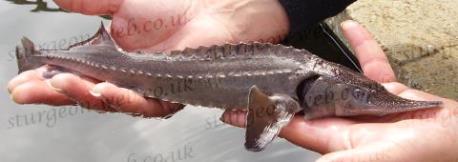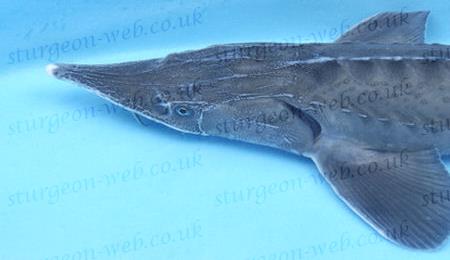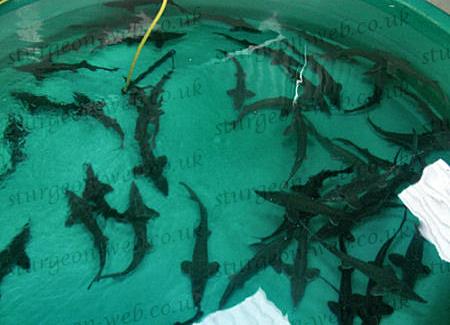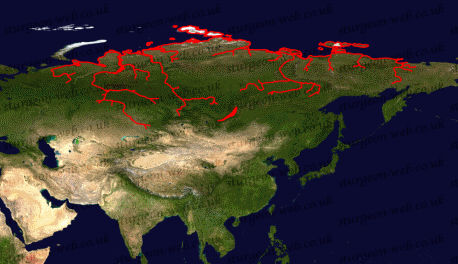Siberian Sturgeon (Acipenser baerii)
The Siberian Sturgeon (Acipenser baerii) is one of the most common species seen for sale, it is easier to breed than other species and it grows very quickly with very few health problems.

Siberian Sturgeon (Acipenser baerii)
A. baerii is often sold under the common name of "long nose" or "longnose sturgeon", which is somewhat unhelpful in species identification because some other species on sale have equally long or even longer snouts.![]()
The Siberian Sturgeon grows very quickly and will soon out grow the average pond. The skin is brownish grey to black in colour and the ventral (under side) is whitish, sometimes with grey spots. The Silver Siberian is seen for sale occasionally and, if you can afford it, makes a very beautiful silver grey specimen although they do sometimes darken with age.![]()
A good fish for the larger pond as it grows very quickly and is hardy. It will go with bigger fish without any problems and is not a threat to other smaller fish. Extra oxygenation in the summer months is essential. Siberian Sturgeons do not tolerate strong treatments such as formalin.![]()
Description
Acipenser baerii has 10-12 dorsal scutes, 32-62 lateral scutes, 7-16 ventral scutes, 30-56 dorsal fin rays and 17-33 anal fin rays.![]()

Siberian Sturgeon (Acipenser baerii)
The back and sides are a uniform dark grey-brown to black, with the scutes and fin edges being very close in colour to the surrounding skin. The belly is whitish and may have some grey spots. The snout is long and pointed with a white tip that may be slightly upturned and rounded.![]()
In the wild the Siberian sturgeon can grow to a length of 2m (6'6") and weigh around 200kg (440lb). In garden ponds a length of 1m (3'3") - 1.5m (4'6") and 10kg (22lb) in weight is considered a large specimen.![]()
The growth rate is dependent on food quality and temperature but when young they can grow like weeds, putting on 8 - 10 inches (20 - 25cm) over a year, given the right food and environment. The growth rate slows down once the fish has reached about 3ft in length.![]()
Recommended Pond Size
Siberian Sturgeons will quickly outgrow smaller ponds of 2,000 - 3,000 gallons (9,000 - 13,500 litres) that the Sterlet (Acipenser ruthenus), with their slower growth rate, would do well in for longer. They may be kept in a pond of 3,000 - 6,000 gallons (13,500 - 27,000 litres) for some time but a pond of 6,000 - 8,000 gallons (27,000 - 36,500 litres) or more is recommended to keep Siberian Sturgeons into maturity.![]()
Food & Feeding
Feeding Sturgeon and koi by Terry Williams (tel51)
Sturgeons DO NOT, as some people would have you believe, eat banket weed or 'clean the bottom of the pond'. Sturgeons need to be fed all year round, they need 2-3% of their body weight of good quality food per day in the summer, less in the winter.![]()
A healthy sturgeon diet must contain a high level of animal protein, sturgeons need a minimum protein content of 40% and an oil level of 15% or more. A a small percentage of the protein can be obtained from soya but the majority needs to be from fishmeal or other animal sources.![]()
Pellet to Sturgeon size:
- 2mm pellet Starter Diet Sturgeon 10-20cm (4-8in)
- 3mm pellet Sturgeon 20-36cm (8-14in)
- 4.5mm pellet - sturgeon size 30-50cm (12-20in)
- 6mm pellet Sturgeon 36-61cm (14-24in)
- 8mm pellet Sturgeon over 61cm (24in)
Stellatus (Acipenser stellatus) and Sterlets (Acipenser ruthenus) have smaller throats; use a size smaller for them.
Buy sturgeon food pellets from Orchard Fisheries »
For more information feeding your sturgeon see our Sturgeon Food and Feeding page.![]()
Health Issues

A tank of 22-24" Siberian Sturgeons (Acipenser baerii)
The most common sturgeon health problems are food and/or oxygen related, get these two vital things right and your sturgeons should remain fit and healthy.![]()
Use an oxygen test kit to make sure there is enough oxygen in the water. Follow the instructions that come with the kit to ensure correct results. Do not assume that there is plenty of air just because you have an air pump running. Many things can affect the amount of dissolved oxygen in the water so testing is the only way to be certain. Warm water holds less oxygen than cold water so be vigilant during hot weather, especially stormy nights when the oxygen may drop to dangerously low levels suddenly.![]()
Feed your sturgeon plenty of the correct food all year round. For more information about feeding your sturgeon see our Sturgeon Food and Feeding page.![]()
Avoid strong chemical treatments such as formalin/formaldehyde, Potassium permanganate, Copper sulphate or any treatment that states not to be used with Golden Orfe (Leciscus sp.) or Rudd (Scardinius reythrophathalmus), these will probably kill your sturgeon. Salt is the safest treatment to use with sturgeons. For more information about treating your sturgeon see our Medications and Treating Sturgeons page.![]()
Provide the best possible water quaility for you fish. Run the pump and filtration all year round and keep a spare back up pump in case of main pump failure. For more information about water quality see our Water Quality page.![]()
Wild distrubution

Siberian Sturgeon (Acipenser baerii) wild distrubution map
The Siberian Sturgeon inhabits the northern river systems of Siberia from the river Ob in the west, including the Yenisei and Lena Rivers, to the river Kolyma in the East and in lake Baikal in southern Russia. There are some non-migrating populations in the Irtysh River system. ![]()
Although the Siberian Sturgeon is an anadromous species that can live in a marine environment and migrate into rivers to spawn, they are most commonly found in the deep parts of the middle to lower sections of rivers, preferring moderate to strong currents.![]()
The Siberian Sturgeon is listed as 'Endangered' on the IUCN Red List of Threatened Species.![]()
Taxonomy
Kingdom: Animalia
Phylum: Chordata
Subphylum: Vertebrata
Superclass: Osteichthyes
Class: Actinopterygii
Subclass: Chondrostei
Order: Acipenseriformes
Suborder: Acipenseroidei
Family: Acipenseridae
Subamily: Acipenserinae
Genus: Acipenser
Species: Acipenser baerii Brandt, 1869
Common names
Lena River sturgeon, Long-nosed Siberian Sturgeon, Siberian Sturgeon
Links
Encyclopedia of Life | FAO Species Fact Sheet | FAO Cultured Aquatic Species Fact Sheet | Fishbase | ITIS | Pond Life | World Register of Marine Species
Written by Terry White & Graham Quick
Contents
Home
Sturgeon Species
Sturgeon Care
Sturgeon Health
Water Quality
Our Other Sites

Copyright © 2000-2024
www.sturgeon-web.co.uk
All Rights Reserved.
Protected by UK Copyright Service Registration No:311386
